Cruise of the Bering Sea
Whoa there!
Take a load off and take a virtual cruise of the
Bering Sea and
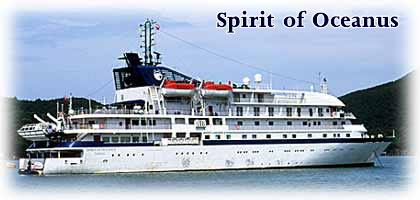 environs aboard
the luxurious Spirit of Oceanus cruise
ship. In July, 2003 my wife, Susan, and I took a two-week cruise
around the Bering Sea, starting at Nome, Alaska, going north to the Bering
Strait, then to Siberia, then south across the Sea, stopping at several islands
where we visited Yupik Eskimo villages and observed seals, walrus, whales, and
zillions and zillions of birds of all kinds, including puffins, auks, and
eagles. The map below shows the major places we visited, but if you
want more than the knuckle-head tour of the area, you can always click on the hyperlinks and
get a thorough description of all the places we visited from real experts.
environs aboard
the luxurious Spirit of Oceanus cruise
ship. In July, 2003 my wife, Susan, and I took a two-week cruise
around the Bering Sea, starting at Nome, Alaska, going north to the Bering
Strait, then to Siberia, then south across the Sea, stopping at several islands
where we visited Yupik Eskimo villages and observed seals, walrus, whales, and
zillions and zillions of birds of all kinds, including puffins, auks, and
eagles. The map below shows the major places we visited, but if you
want more than the knuckle-head tour of the area, you can always click on the hyperlinks and
get a thorough description of all the places we visited from real experts.
Summary of the Cruise (Nome to Anchorage)
Stops 1-2 Nome and Little Diomede (gold panning and Eskimo village)
Stop 3 Provideniya and New Chaplino (two stops in Siberia)
Stops 4-5 St. Lawrence Island (Eskimo village, whales, birds)
Stop 6 Punuk and Nunivak Islands (dead walruses, musk ox)
Stop 7 Cape Cheerful (eagles, zodiac tour looking for seals, birds, etc)
Stop 8 Shumigan Islands, Dutch Harbor (volcanoes, WWII memorial)
Stop 9 Katmai National Park (bears)
Stop 10 Kodiak Island and Homer, Alaska (fishing villages)
Stop 11 Anchorage (cruise ends)

Nome and Little Diomede
After arriving in Nome and looking around for a few hours, we boarded the ship and headed north to a tiny Yupik Eskimo village located on Little Diomede Island in the middle of the Bering Strait. After that, we headed over to Siberia where we spent some time in the town of Provideniya and the Yupik village of New Chaplino.
| Nome: Not much of a town now but I guess about 150 years ago it was the place to be if you wanted to get rich, with the gold boom and all. I don't know if reindeers in pickup trucks are usual fare for downtown Nome, but this pickup with a reindeer in the back came rumbling down the street so we took a picture of it. | 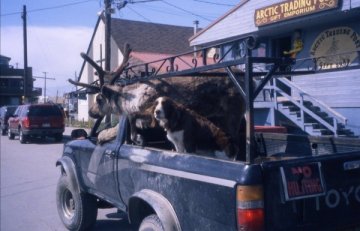 |
| Nome: We did the tourist thing and panned for gold along the Bering Sea coast outside Nome. An old miner told me I panned about 3 cents worth of the stuff. In 1899 the beaches around Nome were packed with prospectors seeking their fortunes. |
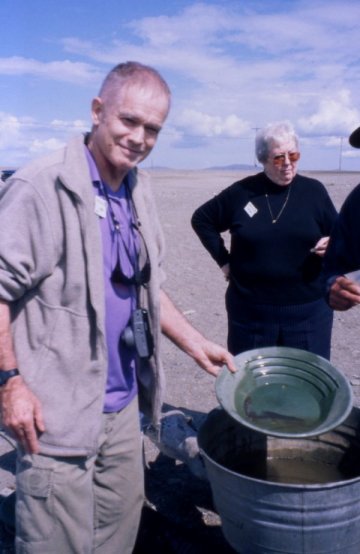 |
| Nome: Susan pets the lead dog of a dog team that competed in the 2002 Iditarod Sled Dog Race . The Iditarod starts in Anchorage and ends in Nome. |
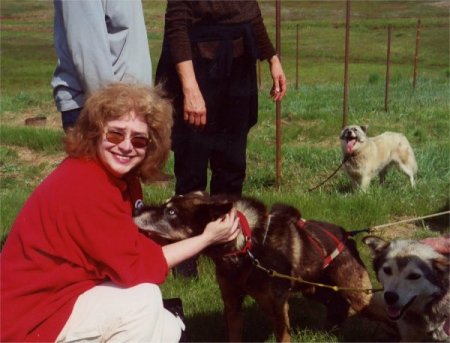 |
| Little Diomede: Right smack in the middle of the Bering Strait between Alaska and Siberia are two tiny islands, Big Diomede and Little Diomede. Little Diomede is in the US and Big Diomede is in Russia. Little Diomede is home to around 150 Yupik Eskimos, which live in the houses you can see in the picture. The people here live on polar bears, whales, walrus, seals, fish, and birds. We were there in July when there was 22 hrs of sunlight each day, the other 2 hrs being dusk. The temperaturewas about 55 degrees. One local lady told us she couldn't stand temperatures over 60. |
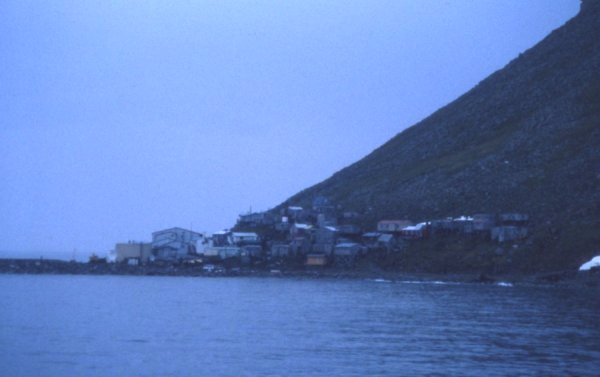 |
| Little Diomede: The Spirit of Oceanus had to drop anchor and the passengers took zodiacs ashore. |
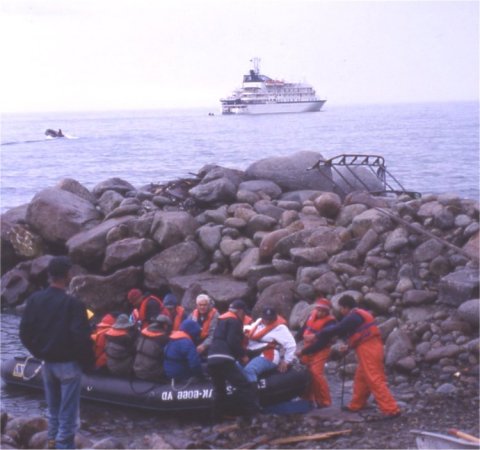 |
| Bering Sea: The only thing I could think of the first day in the Bering Sea is not to fall in the water. The ice had just gone out of the Arctic Ocean where we were a few weeks before and the water temp was a balmy 35 degrees. Susan and I both brought winter clothes, and I'm darn glad we did. |
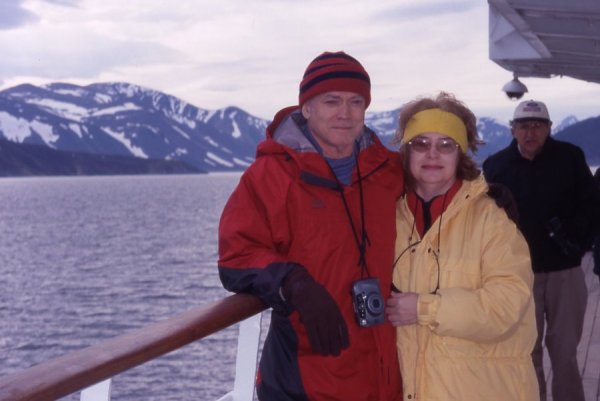 |
| Little Diomede: Typical house in Little Diomede with a polar bear hide draped over a snowmobile. Raw meat of some kind is hanging over a board in front of the house. The meat is eaten raw. |
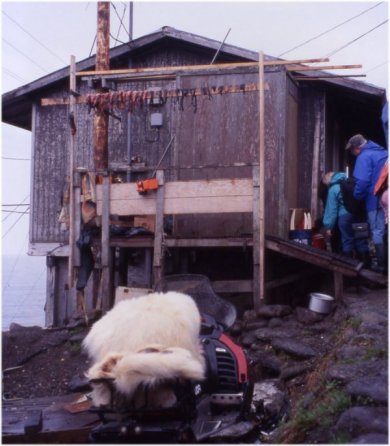 |
| Little Diomede: I don't know what kind of meat this was; we were told it was seal or walrus. All I know is it didn't smell very good to me. You can see Big Diomede Island a couple miles away in the background, which is in Russia. The International Dateline passes between the two islands, so it is one day later on that island. I guess this is one place where you really can see the future. | 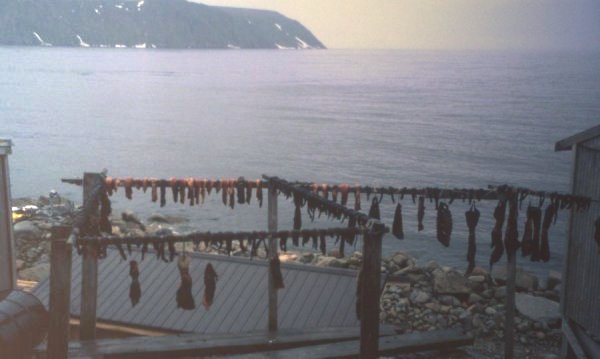 |
The first Europeans to come to this part of the New World were Russian explorers, led by the Danish sea captain Vitus Bering. They trekked six thousand miles from St. Petersburg across the wasteland of Siberia to the Bering Sea, where they then built a ship and sailed east to find the New World. You can read more about the epic voyage of the St. Peter, and how the seamen either died of scurvy or froze to death by clicking on Vitus Bering. Clearly, Christopher Columbus had it much easier when his ships came to the New World from the east 250 years earlier in 1492. Columbus and his supporters were looking for spices, whereas the Russians were looking for otter pelts. Although the Spanish didn't find spices, the Russians found a lot of otters; in fact within 100 years they almost exterminated the entire Pacific population, estimated at three million.
The End